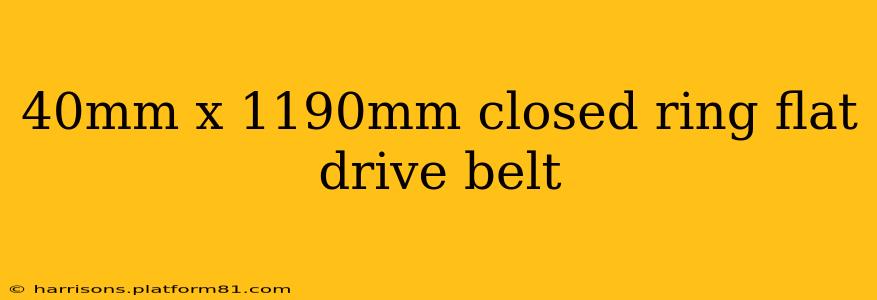Finding the right flat drive belt can be crucial for the smooth operation of your machinery. This guide delves into the specifics of a 40mm x 1190mm closed ring flat drive belt, exploring its applications, specifications, and considerations for selection and maintenance. Understanding these aspects will help you ensure optimal performance and longevity of your equipment.
What are the Applications of a 40mm x 1190mm Closed Ring Flat Drive Belt?
A 40mm x 1190mm closed ring flat drive belt, with its substantial width and length, is typically employed in applications requiring significant power transmission and durability. These include, but are not limited to:
- Heavy-duty industrial machinery: This belt size is well-suited for large industrial equipment such as conveyors, agricultural machinery, and material handling systems. The larger width allows for higher power transmission capabilities compared to narrower belts.
- High-torque applications: The robust construction of these belts can withstand substantial torque loads, making them ideal for applications demanding high power transmission.
- Continuous operation: The closed ring design eliminates the need for splicing, ensuring consistent power transmission and reducing the risk of belt failure during continuous operation.
The exact application will depend on the specific material and construction of the belt. Different materials offer varying levels of resistance to abrasion, heat, and chemicals, tailoring them to specific environmental and operational needs.
What are the Key Specifications of a 40mm x 1190mm Closed Ring Flat Drive Belt?
The specifications of a 40mm x 1190mm closed ring flat drive belt are essential for proper selection and installation. Key parameters include:
- Width: 40mm – This refers to the belt's width, dictating its power transmission capacity.
- Length: 1190mm – This is the overall length of the closed loop belt. Accurate measurement is crucial for proper fit and function.
- Thickness: The thickness varies depending on the belt's material and construction. Thicker belts generally provide greater strength and durability.
- Material: Common materials include rubber, polyurethane, and other specialized compounds designed for specific operating conditions. The material choice directly impacts the belt's lifespan and resistance to wear.
- Tensile Strength: This indicates the belt's resistance to stretching under load. Higher tensile strength equates to better performance and durability.
Always consult the manufacturer's specifications for precise details on the belt's properties.
What Material is Best for a 40mm x 1190mm Closed Ring Flat Drive Belt?
The ideal material for your 40mm x 1190mm closed ring flat drive belt depends entirely on the specific application and operating conditions. Some common materials and their properties include:
- Rubber: Offers good flexibility and cost-effectiveness, suitable for many general-purpose applications.
- Polyurethane: Provides superior abrasion resistance, higher tensile strength, and better resistance to chemicals and oils compared to rubber. Ideal for demanding environments.
- Neoprene: A type of synthetic rubber offering good resistance to oils, grease, and many chemicals.
How Do I Choose the Right 40mm x 1190mm Closed Ring Flat Drive Belt?
Selecting the correct belt involves considering several factors beyond the basic dimensions:
- Power transmission requirements: The belt must be capable of handling the required power load without excessive slippage or premature wear.
- Operating speed: Different materials and constructions are better suited for various speeds.
- Environmental conditions: Exposure to extreme temperatures, chemicals, or oils necessitates the selection of a material with appropriate resistance.
- Pulley diameter: Ensure compatibility between the belt's dimensions and the pulleys' diameters for proper fit and to prevent premature wear.
What is the Maintenance for a 40mm x 1190mm Closed Ring Flat Drive Belt?
Regular maintenance is vital for extending the lifespan and performance of your belt. This includes:
- Regular inspection: Visually inspect the belt for signs of wear, damage, or misalignment.
- Tension adjustment: Maintain the correct belt tension to prevent slippage and premature wear.
- Cleaning: Keep the belt clean from dust, debris, and contaminants.
- Lubrication (if required): Some belts may require lubrication, depending on the material and application. Consult the manufacturer's recommendations.
This guide provides a comprehensive overview of 40mm x 1190mm closed ring flat drive belts. Remember to always consult the manufacturer's specifications and recommendations for your specific belt and application to ensure optimal performance and safety.
